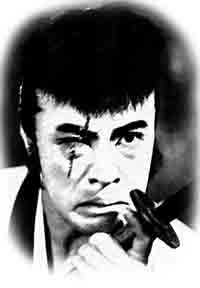The reaction to my previous post on the supposed scandal at the Japan Foundation has been quite positive, so I thought I would update everyone on some of the discussions that have ensued.
There were a number of reactions on KineJapan, with Mark Roberts in particularly asking the crucial question of what may constitute the structural reasons behind the suspicious contracts. Part of the Asahi's laziness was in easily laying blame on the JF, but not asking how it is that film companies can get away with asking for such contracts. To Mark,
Actually, this seems like an opportunity to air out this relationship and, if necessary, publicly interrogate the constraints imposed by the rights holders and the government stance that tacitly supports them. Isn't it equally possible -- and actually rather likely -- that the rights holders have all the cards, and that taxpayers are being asked, in effect, to subsidize their exclusive ownership of Japanese film heritage? And where is the Japanese government in all of this? Standing on the sidelines?
I would think that these relationships are an important matter to establish and publicize (i.e., who is really beholden to whom? etc.), if only because this is an occasion to address an impasse in the promotion of Japanese cinema, both internationally and domestically. Others more knowledgeable than I may know the details, but it feels like there is still more speculation than fact, more opacity than transparency concerning these policies.
Mark is echoing a concern many of us have, and which I have aired before: that the current climate surrounding copyright, especially over protecting the ownership of "contents," is stifling scholarship, harming the promotion if not creation of Japanese cinema, and undermining the preservation and communal appreciation of the cinematic heritage. It seems that, all too often, government agencies which should be looking out for the common good with regard to Japanese film, are just buckling to the demands of private companies, who are often not only self-interested but also short-sighted in asserting what is best. This problem is true not only of the JF, but also of institutions like the National Film Center, which I think asserts the rights of film producers and copyright owners more than those of scholars, viewers, or even archives. It seems that the Asahi, which itself is one of these rights holders for various media contents, is only furthering its interests, and not that of the public, by blaming a weak institution like the JF and completely ignoring the power abuses of rights holders.
I should note, however, that rights holders are not of one kind and the power dynamics are complex. Over the last 15 years, I've written kaisetsu for literally hundreds of the films in the JF collection, so I have a good sense of what they have. It should be stressed that many of the films in their collection are from smaller or independent production companies, including quite a number of works that were never commercially released but only sent around the country to show at public halls, etc. I think it would be a mistake to think that the JF is simply buckling under to pressure from powerful rights holders. In fact, I think the JF has relatively few films from Toho, which is now the most annoying about rights (though that might also have to do with the fact that Toho doesn't care much about showing its catalog abroad unless big money is involved). Big companies like Toho, Shochiku and Toei may make some of these demands, but I also had the feeling when I learned of the suspicious contracts that some of them may be backdoor attempts to subsidize independent producers. I can't confirm the intention, but that has probably been the effect in some cases. This does not obviate the above arguments about rights, but it does complicate the history of this practice, and underlines how the government subsidy system itself is rather haphazard and illogical. And it does compel us to consider what rights could mean for independent producers as well. It was great that when we showed one of the dokuritsu pro films from the 1950s at Yale, the rights holder was so happy he let us have it for just the cost of shipping. But I don't think independent producers are all like that. Where do they fit in the picture?
The general sense on KineJapan, I think, was that more needs to be done to right the imbalance by pressuring government agencies higher up, ones that have been complacent so far. Here again was Mark:
It may be that nothing short of direct government intervention is going to change this situation. This is my sense of the situation, though I admit it's a hypothesis, based upon a limited understanding. Perhaps this issue can also be seen in light of what is now a worldwide battle between media consumers and rights holders, with the former in a state of revolt against DRM technologies and pro-industry policies that are working to gate access, erode fair rights' use, etc. In Europe and America, especially, the industry is responding with a lot of money to buy lobbyists, lawyers, judges, etc. The history of the Japanese cinema itself seems to demonstrate that the industry really does not care deeply about film culture or heritage. As Bazin once said: "film is not an art AND an industry, but instead an industrial art that is likely to vanish into thin air as soon as the industry's profits disappear".
W.r.t. the situation in Japan, should the goal of further discussion be an exploration of government policy on film heritage, with initiatives for education and research that, in effect, force the rights holders to play ball with institutions like the JF and NFC? Which policies have worked in other countries that are more pro-active on this? What arguments can be made to gather support for policy changes?
I'm not sure what the best forum for generating discussion about this issue would be, or how to best frame it, but an article written in Japanese that tries to speak to a broader public might be good.
I agree with this assessment and this plan, but unfortunately I have few connections myself with the major media in Japan, which is where such an article should be printed.
Finally, one other major point discussed was the JF keeping its list of films secret. This only illustrates the lack of logic behind cultural policy. On the one hand, the government lacks the experts to program films and to teach people in foreign communities how to watch the variety of Japanese movies that exist. Yet keeping the list of films secret - even from institutions like Yale that are willing to pay for the screenings (and thus don't fall under the rubric of the suspicious contracts) - means that only experts can use the JF collection. As many reiterated, the JF is very helpful, but only if you come to them with a list of films you want to show; they will then tell you if they have them or not. You thus need to know a lot about Japanese cinema before you even approach them. By keeping the list secret, the JF is again failing in its educational role. So it's no wonder few are using this collection.
Why does the JF keep the collection secret? Many have asked, and the answer is always that the rights holders demand it be kept secret. The films do not belong to the JF, so everything about them is ultimately up to the rights holders. Why would the rights holders prevent the release of information that could promote their films, earn them some money in rentals, and generate interest in Japanese cinema as a whole? I don't know for certain, but it's again likely short-sighted self-interest: the companies don't want people to know of this more convenient and somewhat less expensive way to rent or watch these films for single events and occasions; they want "real business" which involves selling foreign distribution rights. In other words, I think they fear the JF becoming a competitor or a substitute for foreign distribution. This is short-sighted because the vast majority of films in the JF collection will never be bought for DVD or theatrical distribution abroad. In fact, by being kept secret, they most definitely will never be sold because the buzz you need to generate for a commercial release cannot be achieved without spreading awareness of both your film and Japanese film as a brand through such screenings. (It reminds be of the TV networks, which I've talked about before.) It again seems like they are shooting themselves in the foot.
As Mark asked, what would happen if the JF refused to sign any contract that didn't allow them to publicize the films they contracted for? Would the companies all refuse, even the independents? And if they did, would the government step in to pressure companies to stop thinking about their own short-term return and begin contemplating the long term, a future that must be shared with Japanese film as a whole?
The answers to such questions are important, and much of the fate of Japanese cinema depends on such decisions.
style: many of the cool stills you see of the Nikkatsu films that are finally getting released outside Japan were shot by him. He also did stills on films by directors such as Imai Tadashi, Imamura Shohei and Ichikawa Kon. He would be a central figure for anyone writing a history of Japanese stills photography (a history which should be written some day), and a fascinating case where stills began to effect the style of the films themselves.


